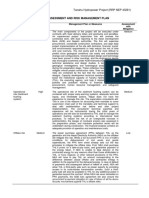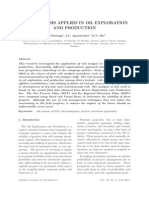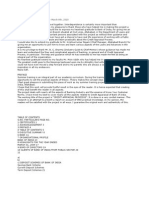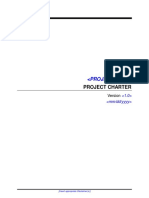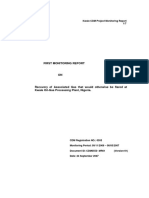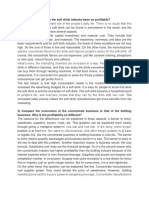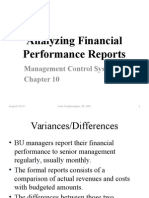Page 1 of 3
Summary of the Operation Performance Evaluation Review
Review evaluation of an oil field development
January 2007
THE PROJECT
In 2002, the Board approved an A/B project finance loan with the purpose of developing oilfield
reserves.
PROJECT RATIONALE
The project was fully consistent with the sector and country strategies. The joint venture (JV)
gave equal weight to each partner. One company (company A) was expected to provide
advanced technology and management and therefore training skills, and an environmentally
friendly approach to an oil project development, including significant levels of associated gas.
The other (company B), through its existing ownership of a similar company would bring the
knowledge of the local environment and through its position as one of the largest domestic
integrated oil companies, the ability to handle issues related to pipeline capacity allocation and
domestic marketing of crude oil. The financing structure as a true project financing post
completion was to be a breakthrough for the financing markets with high demonstration effect
potential for a non- Project Sharing Agreement (PSA) oil project.
ACHIEVEMENT OF OBJECTIVES
Three main objectives were set at approval, namely: demonstration effect derived from
supporting a successful non-PSA-related joint venture with a reputable foreign strategic investor;
the setting of high standards for business conduct and compliance with sound environmental
policies in a sensitive ecological context. The project was implemented to a large extent on time.
There were bottlenecks with regard to transportation that prevented shipments and delays in
drilling activity. These resulted in large overruns compensated by a lower cost for the Central
Processing Facility (CPF) and higher revenues from lower level of production due to a
significantly higher price of oil. In spite of these shortcomings, EvD regards the successful
implementation of the project as being Achieved.
Company A imposed on the JV its high standards of corporate governance. This was evidenced
by the production of IAS financial accounting and timely reporting in respect of financial
operating and environmental matters. Considering that some grey areas remained in respect of
pricing transparency and that high corporate standards imposed under the control of this
company may no longer be followed with as strict a discipline, corporate governance is rated by
EvD as Partly Achieved.
The Environmental Impact Assessment was completed independently on behalf of the JV in
1998. An Environmental Action Plan was developed by the bank and an independent
environmental audit was undertaken in 2005. In the absence of an environmentally conscious
partner there will be little incentive for Company B, which has now prepaid the loans, to abide
by the project undertakings with respect to gas flaring. With little prospect for an improvement
of this situation, EvD’s rating of the achievement of this objective is therefore Partly Achieved.
The rating of overall fulfilment of objectives gives due consideration to the fact that the first one,
considered as having been achieved, is in fact a collection of a number of sub-objectives and
should therefore be assigned a greater weight than the two others which have been only partly
achieved or not achieved. Achievement of Objectives is therefore assigned a Satisfactory rating.
OVERALL ASSESSMENT
� Page 2 of 3
The Bank’s project financing of the oilfield development carried a strong potential to be a highly
successful investment: a creative way of raising funds for a joint venture between a large
domestic oil company and a strategic foreign co-sponsor, in an untested legal framework and
with sound environmental objectives. The economic success of the project leading to the
prepayment of the loan and an easier early retirement of the foreign sponsor is partly responsible
for some of its shortcomings.
Fulfilment of Objectives was rated Satisfactory only because achievements under the joint
venture are unlikely to be pursued under the new management and unfulfilled environmental
undertakings may never materialise. Transition impact was similarly affected by the lack of
continuity and replicability of some of the short-lived realised features. With due consideration
for actual achievements in this respect, overall transition impact was nevertheless rated Good. In
spite of the ongoing high level gas flaring, which lowered the extent of environmental change to
Some, the environmental performance of the project was attributed a Good rating. The project’s
financial performance is Excellent, this is indeed fortuitous as the project started off with
significant cost overruns but the unexpected surge in the price of oil more than compensated for
such initial setbacks.
The Bank’s additionality at appraisal was Verified in All Respects as there is no doubt that the
Bank was instrumental in the success of the project financing, which would not have attracted
any commercial lender had it not been put together under the leadership of EBRD. Through its
selection of the project, the structuring and syndicating of the financing, the monitoring of the
project company and assistance in smoothing out partners’ relationships at management level,
the banking team displayed outstanding skills and Bank Handling was consequently rated
Excellent. EvD therefore assigned a Successful rating to the project Overall Performance.
TRANSITION IMPACT AND THE BANK'S ADDITIONALITY
The joint venture delivered most of the anticipated transition impact as could be predicted at
appraisal. Most achievements in terms of transition impact being mitigated by the strong
uncertainties looking forward, EvD’s rating of overall transition impact cannot be better than
Good. The Bank was clearly additional on all counts in this transaction. The strong appreciation
of the price of oil made both company B and the project cash rich and the financing somewhat
redundant. The Bank’s financial additionality had also been negatively affected by company A’s
withdrawal from the joint venture. At the time of approval, however, the Bank’s additionality
was Verified in All Respects.
BANK HANDLING
Project selection was excellent, helped by the long gestation period during which the Bank
became thoroughly familiar with the corporate environment as well as physical constraints of
this environment. The banking team had already established a relationship with company B and
was aware of the inherent challenges. It developed a very good relationship with company A
who valued highly the Bank’s involvement as a project lender.
The prepayment of the facility could have hardly been predictable or avoidable. It is reasonable
to suspect that, once on its own, company B was eager to do away with the reporting and
environmental constraints attached to the project financing. However, the project’s and the
parent company’s cash build up due to the rise in crude oil price are bound to have been the main
reason for the prepayment. This resulted in the Bank being deprived of high revenues for the last
two years and the profitability of the operation was further reduced. The project nevertheless
generated enough revenues to comfortably cover the Bank’s cost and its profitability was rated
Satisfactory according to EvD’s own standards.
� Page 3 of 3
EvD regards the prepayment of the loan and the less-than-cooperative attitude of the remaining
shareholder as external elements to the project itself which the banking team had to cope with as
with other uncertainties that could not have been foreseen. In the event, monitoring by the Bank
was of very high quality and its involvement to broker a new shareholder agreement was
commendable. The structuring of the loan documents did not allow for the gas flaring issue to be
tackled as early as would have been desirable, however, the Bank’s professional handling of the
general structuring, documentation and syndication of the project financing deserved and
obtained highest recognition. Bank Handling is therefore assigned by EvD an Excellent rating.
LESSONS LEARNED
Lesson: Political risk may be better mitigated by the choice of the local partner than by the
legal framework that governs the project. Governments have levers available outside the
operating framework to try and renegotiate a contract that may have been regarded as offering
the best protection against an attempt by the local Government to alter the pre-agreed economics
of a project in the extractive industry. This is being experienced in this country as well as in
other countries of operations of the Bank. In this case, however the presence of a strong local
partner as 50 per cent shareholder may well have been the best avenue to mitigate political risk.
Lesson: A 50/50 joint venture increases the risk of management deadlock detrimental to a
project. In this case, the bank acted with tact and diplomacy which may have been helped by the
increasingly favourable economics of the project which created a strong incentive to find a
solution. This was obtained by elevating controversial issues to shareholder level, thereby by-
passing local susceptibilities. It also required sweeping management changes to give the new
agreement a chance to work satisfactorily.
Lesson: Important environmental undertakings should be covenanted in the loan
documentation. It is not sufficient to rely on the knowledge that the technical development plan
calls for environmental remediation if the project has been approved by the Board on the basis
that such key investments would make it environmentally sound. Non-compliance with such
undertakings should translate into a breach of covenant requiring a formal waiver by the Bank.
In accordance with Bank’s procedures regarding waivers, amendments and consents, this would
thus lead to informing the Board on non-compliance with material environmental/safety issues
as would be the case for other material conditions.
Lesson: The negative impact of prepayment of a project loan may be alleviated through
proper pricing. The profitability of an investment is analysed on the basis of its IRR through
discounting net cash flows. In addition to the collection of a prepayment penalty fee, the loss of
higher margins on reducing principal amounts at the tail end of the facility’s life are easily
compensated by fees received up front and calculated on the full amount of the facility. The
Bank should always seek to maximise up-front fee collection particularly in situations where
fluctuating commodity prices are an unpredictable possible cause for prepayment.





